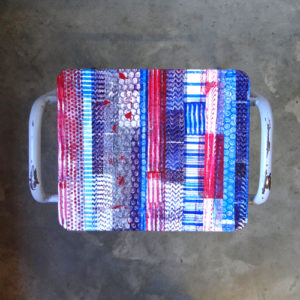You may have seen Zeena at the Handmade Fair or Handmade Christmas Fair this year or even taken part in one of her workshops! If not, it’s about time you
meet Zeena Shah!

Hello! I’m a Printed Textile Designer & Maker based in East London. I screen print and sew a collection of textile goods for your home as well as teach
workshops all over London and the UK sharing my printing know how and tips. I have just launched my first book ‘How to Print Fabric
‘ that features twenty projects that you can print and sew!
Describe your design process.
I’m always so inspired by nature and the everyday, a design often emerges because I’ve collected a bundle of leaves from some fallen trees, drawn them
and then cut them out of paper ready for a stencil screen print. Then there will be a bit of experimenting until I have the right layout, shapes and
colour before it a design is turned into a product ready to sell.

How and where did you learn to design and print textiles?
I studied Textile Design at Chelsea school of Art in London. It was a wonderful course, we were all one big happy textiles family!
Why textile printing?
I actually didn’t intend on being a Textile Designer when I first started my Art foundation course, I thought I might be graphic designer or a fashion
stylist but something just clicked with printmaking and that’s how it all began!

Where do you work?
I work in my East London studio space, it is very chilly at the moment as we have no heating!

Describe a typical day in your studio.
I arrive at the studio bright and early, I seem to spend most of my time lately at my mac, replying to emails, business admin etc but I try to only spend
the first part of the day at my desk and then it’s over to the print table to make up my orders, work on commissions or package up some books. I’m
a bit of a workaholic/ night owl and am often still in the studio past 7pm (it’s always my most creative time) before heading home for the night!
How long have you been printmaking?
Since I graduated from art school in 2007! Gosh I feel old..! That’s 8 years of glorious printmaking!
What inspires you?
Everything and anything from the weather outside to nature and animals. These are always the most prominent images found in my collections and my favourites.

What is your favourite printmaking product?
It would have to be my silk screen and squeegee, I couldn’t live without these two things although a piece of lino and a lino cutter aren’t far behind!
What have you made that you are most proud of?
I would have to say that would be my book! How to Print Fabric
was published just over a month ago and I still can’t quite believe it’s here. It is a real labour of love and a collection of twenty of my favourite
printing techniques and sewing projects. It includes things I really love making and wanted to share with my wonderful followers and friends.

Where can we see your work? Where do you sell?
You can find my work on my website www.zeenashah.com as well as Etsy and various other stockist all over the UK and worldwide. My book can be found on Amazon.
What will we be seeing from Zeena Shah next?
I’ve actually just finished my second book…! It will be a beautiful illustrated adult colouring book with 48 illustrations designed and hand drawn by
me for you to colour in! It will be out next year so keep your eyes on my social networks to find out more!

Do you have any advice for other printmakers, designers and creatives?
Stay true to your own voice, keep going as hard work and determination will pay off in the end!






































































































































